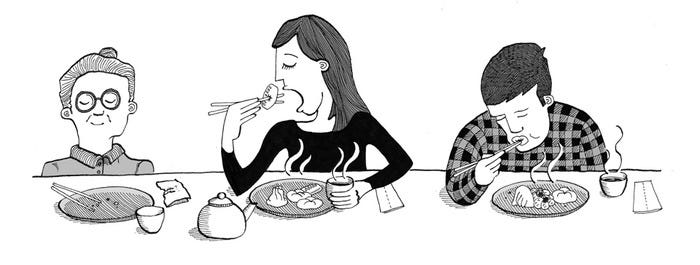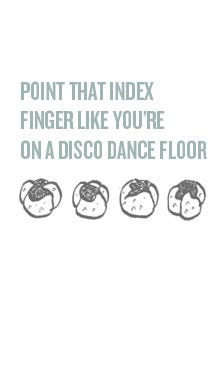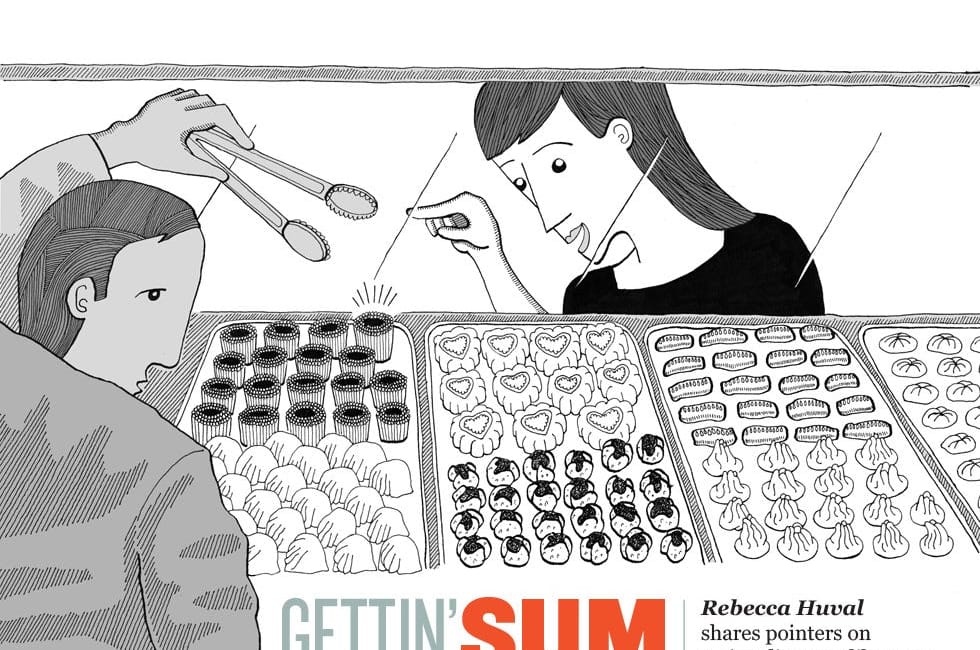
Whenever I eat dinner with my boyfriend’s Chinese family, I find a new opportunity to humiliate myself. In a fit of frustration, I have stabbed a slippery slab of cheong fun (rice noodle rolls) with a single chopstick. I have also balanced a hunk of roasted chicken across an endless expanse of white tablecloth, only to drop it. My significant other laughed when a waiter slipped a fork to the only white girl in the Cantonese dining hall. I was insulted and secretly thankful.
If Chinese dinners are my personal shamefest, then dim sum brunches are remedial cotillions. We wake up hung over on Sunday mornings, when a creamy egg tart sounds like the best cure. At crowded dim sum counters, my beau teaches me how to step in line with Chinese grandmothers who jostle to bring home a bounty of char siu bao (steamed pork bun). I gawk at the shapes inside the counter and imagine the scrumptious surprises inside those golden brown buns. Even my Hong Kong–native boyfriend is sometimes at a loss for answers. After waiting in line, I point at the object of my desire and ask the cashier the question that has built to a boil inside of me: “What is that?” I jab my finger at 10 buns and ask the same question over and over like a crazed toddler.
After a year of lessons, I can identify the basic dumplings, including the prime dishes for my boyfriend’s pescatarian diet. I have also refined my manners for dim sum counters and cart-style restaurants: Pointing is encouraged, if not necessary, and you won’t befriend your server by asking a dozen questions, but you will find life-changing delicious breakfast treats you never knew existed. Now I’m ready for the final test before earning my dim sum diploma. I’ll share what I’ve learned.

Walk the Line
At lunchtime in Chinatown, the sun intensifies the salty-sweet smells of barbecued pork and chives marinated in soy sauce. Locals bounce around the steep sidewalks with tall grocery carts in tow, and pop in at dim sum counters as their crowning errand. To contend with all that native know-how, it helps to have a general sense of dim sum etiquette before stepping in line.
Brace yourself for confusion. It’s part of the adventure. Good Mong Kok Bakery is plastered with beautiful red menus explaining all the details of its dishes — in Chinese. The one piece of English writing? “All the Dim Sum inclubed [sic] tax.” On a busy day, the line trails outside the building, where it can be difficult to ogle all your dumpling options. This is where shamelessness comes in handy. I often inspect the fragrant lotus wraps and red bean buns in the window, fogging up the glass with my excited breath, and ask the person next to me about the ingredients. Even if you know the dim sum drill, it helps to understand that in Cantonese culture it’s common to ask strangers questions, unlike the United States of Anxiety. If they shrug, worry not. Once you get to the front of the line, you can ask the cashiers your every burning question.



Give the Finger
Inside a dim sum counter, you’ll see bins of savory confections protected by wicker and stainless-steel tops. Your server will uncover them to release a veil of steam that always gets me salivating. Don’t be afraid to ask what’s underneath the top level because different dishes are tiered within the stacked trays. You might notice it’s even common for patrons to request one specific dumpling over another of the same flavor simply because they prefer its shape. Lesson: Don’t be shy. You can be as picky as you like and it won’t be considered rude. On the same token, if your server gives you blunt answers, don’t take it personally.
Point that index finger like you’re on a disco dance floor. You could even extend your arm over the counter to get your finger closer to the exact dumpling of your desire, and you won’t get mad-dogged. If you ask for a vegetarian dish, prepare to be met with a grave “no.” (See the Cantonese glossary below to learn the V-word.) Press for the dessert options, as you might find some delectable sesame balls or almond cookies tucked in the back.
Order anywhere from six to ten dumplings for a full meal. At lunch, I feel pleasantly plump after six savory pieces plus one dessert. Best of all, I can feed myself on less than $5. Some take-away counters don’t sell drinks, so come prepared with water or a box of chrysanthemum tea from a nearby market.
At this point, you might look around for a chair and find none. The better spots are outside anyways, where you can find bookstores and intricate alleyways to lean against. A block away from Good Mong Kok Bakery, inside Ross Alley, you can idle beside Jun Hu’s Barber Shop and listen to the barber play the erhu (Chinese double-stringed fiddle) outside his doorway.

Come to Order
The sit-down restaurant is a different story. Dim sum literally means “touch your heart,” and sit-down brunches are the heart of dim sum. Originally, the meals were a snack to nourish farmers and travelers in rural China. Today, the drawn-out feasts allow families to bond over gooey steamed buns, mango custards, and garlicky shrimp rolls. Oh, and they’re also delicious.
The most overwhelming step of a dim sum brunch is at the beginning. When you approach the swarm of families lined up for a table, please ask someone what to do. Each white-tablecloth dim sum restaurant in San Francisco has its own process. You probably have to take a ticket, wait in line, huddle outside to hear your lucky number — or some combination of the above. It helps to come with a party of friends — about four to six — for body warmth, not to mention you can appreciate more dishes and partake in the party atmosphere.
When you’re finally seated, a waiter will greet you with a warm pot of green tea and at some restaurants, a pencil to mark your choices on a paper menu. To be polite, pour everyone else a cup if you’re the first to nab the pot. (Insider tip: If you want a second dose of tea without having to ask, leave the top of the teapot open.) Don’t be alarmed if you see families soaking their cutlery and bowls in the tea — it’s a remnant of the SARS epidemic in Hong Kong. Diners perform the ritual to be oh-so sure that tableware is disease-free.
Next, you’ll sing “hallelujah!” when you see that the menus explain dishes in English. But not so fast — these menus aren’t the most thorough. One dish at Hong Kong Lounge is mysteriously labeled “BBQ Pork Puffed.” Even after asking a waiter, you might have to order a dish to be absolutely certain what it is. In this case, BBQ Pork Puffed was a crescent-shaped, flakey pastry, glazed with honey and stuffed with sweet BBQ pork bits. You’ll often get a heavenly surprise.
Cart-style restaurants offer the most novelty. Servers wheel multilevel food carts between the tables like a moving menu, allowing you to scope out your meal before you commit to it. It’s perfectly appropriate to raise your hand to catch a waiter’s attention. Veggies beware: What you see is not always what you get. Even if the server tells you a dish is tofu, bits of chicken might be hiding inside. Ask the server flat out if the dish has any meat, or bring a carnivore as your taste-tester.
Unlike a dim sum counter, where you get a flimsy plastic fork, the sit-down restaurant will issue elegant chopsticks. If you need the out, don’t be embarrassed to ask for a fork. But before you do, know that there is no wrong way to pinch chopsticks as long as they successfully deliver food to your mouth. I’ve seen adults in Hong Kong holding chopsticks like kids gripping crayons. Also, as long as you’re among friends or family, it’s acceptable to subtly stab your food with one chopstick and pinch it on the outside with the other. To make it easier to transport food, you can raise your bowl to your face. And remember that dim sum is not sushi: You don’t need to stuff the whole item down your gullet, nor should you.
To grab a dish across the table, you can reach over everyone else’s dishes, arms, or heads. If you spot someone else’s plate looking lonely, add another helping. You might score some brownie points if your boyfriend’s parents happen to be Chinese and sitting across the table (not that I would know).
Each dish contains three to four dumplings. Despite the white tablecloth, feel free to gobble like the Cookie Monster — it’s not considered rude. Also, there is no set order to the meal, so if you start and end with dessert, it’s okay (finally!). You can always add to your feast as you go along, so pace yourself, and leave room for the fruity custard and pastry options if you haven’t eaten them as appetizers. A side note: I have always broken this rule by ordering too many dumplings and stuffed myself with glee.


Barbecue pork
Char Siu
Beef
Ngow yuk
I don’t eat meat
Ngoh mh’sihk yuk
Pork
Ju yuk
Shrimp
Ha
Sweet
Teem
Salty
Hahm
Salty-wet
(also means perverted)
Hahm sup
Vegetarian
Sik sou

Do It Yourself
Restaurants are often packed on weekend mornings — prime dim sum time. Plan to wait half an hour, and know it’ll be worth it once the sweet white dough of a steamed bun is melting on your tongue. All Season and City View offer the cart-style experience, while at Great Eastern and Hong Kong Lounge, you order by checking off items on a paper menu. Touristy Ton Kiang offers the largest bounty for newbs and vegetarians alike, with options such as spicy okra, asparagus, and dry fried string beans. For a classic counter, try Good Luck Dim Sum or Good Mong Kok Bakery. (Noticing a “good” theme? They live up to the title.)
Dim Sum Eaters Guide
Adventurous Eaters
Chicken Feet
(Fung Zhao)
Difficult to manage with chopsticks, and challenging to eat with your eyes open, chicken feet offer juicy bits of dark meat with garlic-and-ginger infused skin. I busted my chicken-feet cherry at Great Eastern Restaurant.
Octopus Salad
(Hoisin Ping Poon)
Cold and refreshing, octopus salad is often served with chewy strings of seaweed and sprinkled with sesame oil. Also available at Great Eastern.
Turnip Cake
(Law Bok Gow)
These soft browned rectangles of shredded radish and rice flour often contain savory surprises of shrimp and pork. Try it at Good Luck Dim Sum.
Somewhat Daring Diners
Egg Tart
(Dan Tat)
Buttery sweet pastry cups of creamy egg. At first, I thought egg yolk had no business inside what is by all appearances a piecrust, but this dish proved me wrong. It’s now my favorite dim sum dessert. Golden Gate Bakery makes them legendarily delicious.
Pork Dumpling
(Siu Mai)
Blossoming like a honeysuckle, the water-dough petals of pork siu mai reveal a complex cluster of ground pork, shrimp, black mushroom, chives, and a sprinkling of orange crab roe. Delicious at Good Mong Kok Bakery.
Shrimp Noodle Roll
(Ha Cheong Fun)
These gooey rice noodle rolls hold garlicky shrimp and chives. Their semi-adventurousness comes from their presentation: A server will cut them with office-style scissors, then douse them in a sweet soy sauce. Consider making a trek to All Season Restaurant in Diamond Heights for this dish.
Dim Sum Newbs
Chinese Broccoli
(Kai-Lan)
Veggie-friendly and healthy, Chinese broccoli is a palatable vegetable with long stems. At dim sum, a bouquet of broccoli is served warm and seasoned with garlic sauce, soy sauce, or peanuts. Yummy at Hong Kong Lounge.
Steamed BBQ Pork Bun
(Char Siu Bao)
The king of dim sum, char siu baois a steamed ball of pillowy white dough that houses a saucy and sweet core of BBQ pork. Please put down the chopsticks. Eat this and any other dim sum pastry with your hands. They are finger-licking good at Delicious Dim Sum.
Shrimp Dumpling
(Har Gow)
A pleated, paper-thin wrapper holds a steaming ball of shrimp, cabbage, and garlic. Simple and simply delicious. Good Luck Dim Sum does it just right.







